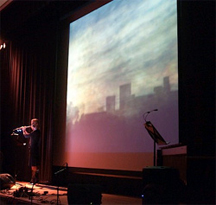
Contemporary French Music Concert with Sonic Generator
Where: Rich Theatre at the Woodruff Arts Center (1280 Peachtree Street NE, Atlanta, GA 30309).
A tribute to the music of IRCAM presented and performed by contemporary music ensemble in residence at Georgia Tech, Sonic Generator. The group explores the connections between cutting-edge technologies and chamber music through unique collaborations between Georgia Tech researchers and the best classical musicians in Atlanta.
The group will play in Atlanta with French composer, Philippe Leroux, who has written pieces ranging from the symphonic to the acousmatic and including vocal, chamber music and pieces for electronic configurations. Soprano Donatienne Michel-Dansac will perform with the group as well.
The concert will be an exploration of the music created at IRCAM, (Institut de Recherche et Coordination Acoustique/Musique) a music institute in Paris and one of the world’s largest public research centers dedicated to the science of music and sound. IRCAM is a uniquely innovative and revolutionary research institution focusing on a broad range of scientific disciplines including acoustics, signal processing, computer science (languages, real-time, databases, man-machine interfaces) musicology, and musical cognition.
FREE AND OPEN TO THE PUBLIC
Sonic Generator
In conjunction with this concert, composer Philippe Leroux will be giving a lecture at Georgia Tech.
The talk is open to the public.
GA Tech’s "C3: Creativity, Cognition and Computation" series and the Center for Music Technology Seminar Series present:
Philippe Leroux, University of Montreal and IRCAM
Voi(Rex) the model of the model
Monday, November 29, 2010
TSRB Auditorium in Georgia Tech’s Technology Square, directions at:
http://www.tsrb.gatech.edu/
Reception at 1:30 pm
Lecture at 2:00 pm
Biography:
Born on the 24th September 1959 in Boulogne sur Seine (France), composer Philippe Leroux graduated from Paris Conservatoire Supérieur where he studied with Iva Malec, Claude Ballif, Pierre Schaeffer and Guy Reibel. In parallel, he also studied with Olivier Messiaen, Franco Donatoni, Betsy Jolas, Jean-Claude Eloy and Iannis Xenakis. Composer-in-residence at the Villa Medicis (1993-1995), he has written some 40 pieces which encompass several genres: symphonic, electro-acoustic, electronic and chamber music. Leroux has appeared as a regular guest at various festivals in France and abroad: Donaueschingen, Présences de Radio France, Bath, Agora, Roma-Europa, Nuove Synchronie (Milan), Musica, Stockholm ISCM, Barcelona, Musiques en Scènes (Lyon, France), Manca, Bergen, Tempo (Berkeley), BBC Symphony Orchestra, among others. He has also been commissioned by the French Ministry of Culture, Radio France Symphonic orchestra, Südwestfunk Baden-Baden, INA-GRM, Les Percussions de Strasbourg, Ensemble Intercontemporain, IRCAM, Ensemble Icare, Festival Musica, BIT 20 and several other French and foreign institutions. In 1994, was awarded the Hervé Dugardin Prize. In 1996, his piece (d’)Aller was nominated “best contemporary composition of the year”. In 2003, he received the SACEM award. Leroux has written numerous articles on contemporary music, and has given lectures and taught composition courses at Bergen Grieg Academy, Columbia University (New York), UC Berkeley (California), Fondation Royaumont, IRCAM, the American Conservatoire in Fontainebleau, the Paris and Lyon Conservatoires Supérieurs, among others. Leroux teaches composition (music electronic) at IRCAM.
Abstract:
The composer writes: “Voi(Rex) was composed using poems by Lin Delpierre, taken from a collection entitled Le testament des fruits. The poems have been freely reordered, even mixed at times. The meaning of the text remains mostly understandable and contributes to the overall expression of the piece, but its structure also determines some of its features. The poems also serve as phonetic material and suggest several figuralisms scattered throughout the piece. The very calligraphy of the letters, as a cousin of the melody archetypes that are soundwaves, is used to generate rhythmic/melodic models and spatial trajectories. Finally, some scenographical movements borrow stylistic and punctuation traits from the poems. The piece is in five movements preceded by a short introduction. Each movement is built over one or several unique features. The idea driving the piece is the confrontation between various model types. What could be called «the model’s model.» First of all, the singer recorded the poems up close to gongs and a tom tom resonating to the sound of her voice. After analysis, this produced the harmonic elements that were used throughout the work. She also recorded an improvised sequence using specific vocal techniques. Recorded sounds were then selected, isolated and worked on using editing techniques only - no treatments were involved. These sounds were then presented to the singer as new models. She now had to imitate herself from a recording that had been stripped out of certain bits of sounds that were recorded the first time. Little by little, this process generated a set of vocal elements that could be used as a model for the instruments and the electronics. A number of technomorphic models were also used, shifting constantly back and forth between voice, instruments and electronics. I would like to thank Frédéric Voisin, without whom this work would not have seen the light of day, Donatienne Michel-Dansac for her great talent and patience, and Gilles Leothaud for his precious advice in writing the vocal part. Voi (Rex) was commissioned by the State and the Ircam-Centre Pompidou, and realized at Ircam with the help of Frédéric Voisin, musical assistant. It is dedicated to François Paris.”
